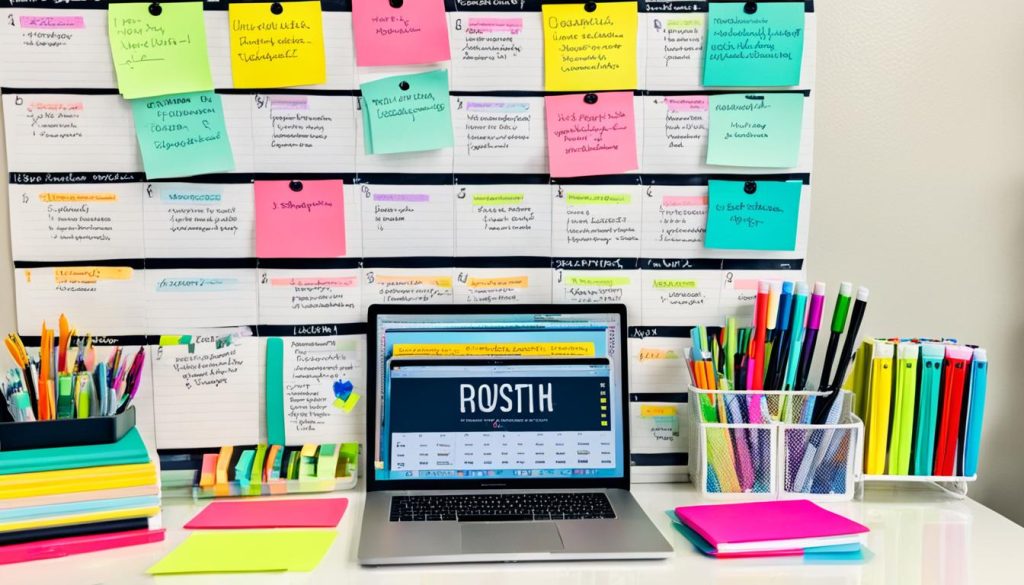Technical issues and bugs can be a real pain in your blogging journey. But don’t worry, I’ve got you covered. This article is here to help you tackle technical issues and bugs in your blog, making sure your site runs well for your readers.
Nearly 40% of bloggers face technical problems often. This big number shows how common and challenging these issues are for bloggers.
But, you don’t have to be overwhelmed. With the right information and tactics, you can beat these challenges. You can keep providing great content for your readers. I’ll show you the steps to maintain your site well, manage content, fix coding mistakes, and solve common site troubles.
Are you ready to take over your blogging journey and manage technical issues and bugs like a pro? Let’s do this!
Challenges Faced by Beginner Bloggers
Starting as a blogger can be tough. Many of us feel like giving up when success seems far. But remember, all successful bloggers started just like us. They faced the same struggles we do now. It’s all about staying determined and tackling these challenges to reach our blogging dreams.
One big issue for new bloggers is getting people to visit their site. It’s demoralizing to work hard on content that few see. This situation hinders building a fanbase. Despite this, keep your spirits up and keep creating useful posts. Use good SEO, make content worth sharing, and interact with others. These steps can help grow your audience over time.
Choosing a blog focus is also tricky for starters. With so many topics, it’s hard to pick just one. Finding a niche is essential for attracting a dedicated following. By focusing on a specific area, you become an authority that people trust. To do this, do your research and follow what you love while looking for niche gaps.
Consistently crafting top-notch content is another hurdle. The pressure to keep creating interesting posts is real. You might face moments where ideas just won’t come. But, creativity is a skill that improves with practice. Establish a content schedule, get ideas from fellow bloggers, and try new styles. This approach will help you keep your readers hooked.
Staying motivated can also be hard when success isn’t quick. It’s important not to let setbacks get you down. Remember why you chose to blog in the first place. Set achievable goals, celebrate each step forward, and connect with other bloggers for support. These strategies can help you power through tough times.
So, getting started in blogging has its share of obstacles. These include low visitor numbers, deciding on a topic, content creation, and consistent quality. However, with perseverance, advice from experienced bloggers, and the right strategies, we can beat these hurdles and find success in blogging.
Bug fixing can also be a challenge in the blogging world.
Overcoming Technical Issues in Blogging
Dealing with technical issues is part of being a blogger. Yet, bloggers can beat these problems to give readers a smooth ride. We’ll look at how to fix website bugs, handle coding issues, and use bug-fixing tricks. This helps keep blogs trouble-free.
Troubleshooting Website Bugs
It’s key to find the cause of website bugs and fix them. Common bugs are broken links and slow page loads. Testing your site often helps spot and fix these bugs.
Google’s Search Console is handy for checking your site’s health. It shows issues and helps you keep your site top-notch. By quickly tackling bugs found here, your site will be more user-friendly.
Addressing Coding Problems
Coding mistakes can lead to site errors. Knowing code basics (like HTML and CSS) lets you understand and solve these issues. But if coding isn’t your thing, many tools and tutorials can guide you. Working with web developers is another option.
Implementing Bug-Fixing Techniques
Making bugs disappear is key to a great blog. Use these steps to keep your website running smoothly:
- Update plugins and themes often for safety and compatibility.
- Back up your site regularly to avoid losing data.
- Track bugs with the right tools, making fixing them easier.
- Always update your software for the latest features and security.
These steps will help you keep your blog bug-free. Following them means fewer tech problems for both you and your readers.
In the end, facing tech issues in blogging need a hands-on approach. By dealing with bugs, managing codes, and using the right fixes, bloggers can keep their sites running well. This makes for happy readers.
The Importance of Website Maintenance
Maintaining a website is key to successful blogging. It’s vital to check for updates and bugs often. Also, making your site work better improves user experience and boosts its place in search results.
Keeping up with website maintenance helps avoid technical issues. By routinely checking for updates, you can prevent bugs from affecting your blog. It also keeps your site secure by using the latest software and security patches.
Optimizing your website’s performance is another big plus. This means making pages load faster, keeping files small, and ensuring images and videos load quickly. These steps make your blog more user-friendly and improve search engine standings.

Regular maintenance is vital for stopping bugs. Fixing errors early ensures your blog runs smoothly. It involves checking often for problems like broken links and errors that spoil the user experience.
Don’t let website upkeep stress you out. Make a to-do list and set regular times for maintenance. Doing this, you stay on top of necessary tasks, ensuring your blog remains high-quality and reliable.
Looking after your website is crucial for a successful blog. Regular checks and managing bugs and performance enhance the user experience. This effort means fewer technical issues and more success for your blog.
Check here for more about website maintenance and blog management.
Harnessing the Power of Pinterest in Blogging
Pinterest has changed the blogging game. It’s a platform that opens big doors for bloggers to get a lot of traffic and promote their content well. Compared to Google, Pinterest gives bloggers a quicker way to get noticed and share their blog with others. If you want more eyes on your blog, using Pinterest is a must.
One big plus of Pinterest is how it drives people to your blog. Make eye-catching pins and use the right words in your pins, and more people will see your content. Because Pinterest is so visual, folks are more likely to stop and check out what you’ve posted, meaning more clicks to your blog.
Also, each pin you make helps with Search Engine Optimization (SEO). It acts like a small webpage that can show up in search results. So, by picking the best keywords, describing your pins well, and sorting them right, your blog can pop up more in searches and bring in visitors.
Pinterest is the place to be for getting your visual content noticed. The site lets you share your blog’s photos, graphics, and videos in a very appealing way. When you make pins that look great and lead back to your blog, you inspire people to visit and see what else you have. Because people love visual stuff, it’s a smart way to get more people aware of your brand and coming to your blog.
Successful Pinterest Bloggers
Think Pinterest isn’t powerful for bloggers? Check out these pros who’ve cracked the code of attracting traffic and sharing their content:
- Susan from “The Healthy Foodie” – Her blog gets over 500k hits a month, thanks to her Pinterest savvy. She makes pins that stand out and draw people in, which has built her a committed fanbase.
- Ryan from “The Adventure Life” – By spotlighting his breathtaking travel photos on Pinterest, Ryan not only boosts his blog’s traffic but also grabs the eye of brands looking to partner.
- Jessica from “The DIY Mommy” – Jessica’s DIY and decor blog is a hit, largely due to her smart use of Pinterest. She crafts pins that invite clicks, drawing in more readers and fans.
Their success stories prove how powerful Pinterest can be for growing your blog. By smartly using Pinterest and showcasing your content with eye-catching pins, you can see your blog’s influence grow.
To get more Pinterest blogging tips and other advice on how to up your blog’s game, have a look at this helpful article: 5 Technical Tips to Keep Your Blog Performance Flawless. It’s full of insights and strategies to improve your blog and see lasting success.
| Benefits of Using Pinterest for Blogging |
|---|
| Drive massive traffic to your blog |
| Boost SEO optimization and increase search engine rankings |
| Promote visual content effectively |
| Attract a larger audience through captivating pins |
All in all, Pinterest is packed with chances for bloggers to shine online, attract new readers, and focus traffic on their sites. By using this powerful platform the right way, you can really amp up your blog’s impact and see great outcomes.
Staying Motivated in Blogging Journey
Staying motivated is key for bloggers to beat challenges and keep going towards success. As a blogger, I know the highs and lows of this creative journey. It’s crucial to stay inspired and focused, especially when things look bleak. During my blogging journey, I’ve found many tactics that kept me going and helped me overcome hurdles.
Setting Goals
Setting goals has been a major help for me. It gives me a path and a reason to keep going. With both short and long-term goals in place, I can keep my eyes on the prize. Meeting these goals, like hitting a follower milestone or posting regularly, keeps my passion alive.
Learning from Successful Bloggers
I learn a lot from successful bloggers who have faced and beaten challenges. Their stories are full of insights, tips, and the drive to never give up. Websites like Never Ending Footsteps are great for new bloggers. They share stories that show it’s possible to make a career out of blogging with hard work.
Celebrating Small Wins
It’s vital to celebrate the small victories in this blogging journey. It’s easy to only look at the big goals we’re chasing and ignore the progress we make each day. By celebrating each small win, like a new milestone or good reader feedback, I keep a positive attitude and stay motivated to move ahead.

Practicing Perseverance
Perseverance is perhaps the most important factor in staying motivated. Challenges will come, but how we tackle them matters most. When I face a rough time, I remember my passion for blogging. I stay true to my goals and tackle setbacks with grit and courage. Perseverance is what sets achievers apart from those who quit.
By setting clear goals, learning from the best, celebrating even the tiniest victories, and never giving up, I keep my motivation high. Success takes time, and facing challenges is part of the path. The success stories of fellow bloggers, who have turned their dreams into successful blogs, inspire me. Are you ready for your own blogging adventure?
Best Practices for Content Management in Blogging
Good content management is key for success in the blogosphere. Following the best content management practices makes sure your work is neat, clearly planned, and highly visible. Let’s look into various methods that can help bloggers better manage their content and make their blogging better.
Organization Techniques
Being organized is crucial when managing blog content. A structured approach helps a lot in keeping up with your blog. There are several methods you can use:
- Create folders or categories to sort your posts by topics or themes.
- Use tags or labels to organize content, making it easier to find specific topics.
- Develop a clear file naming system for blog posts.
Planning Strategies
Planning what you want to write is also very important. This can help you stay on track and avoid getting stuck. Here are tips for planning your content:
- Make an editorial calendar to plan your posts ahead of time.
- Set achievable goals for how often you’ll post.
- Brainstorm ideas and make a roadmap for your content.
Editorial Calendar
Using an editorial calendar can greatly help in managing your blog’s content. It lets you plot out your content strategy over time. An effective calendar includes:
- Important dates and publishing deadlines.
- The topics or themes for each post.
- Who’s writing each post, if you’re not doing them all yourself.
Having a calendar helps you stay consistent with your posts and support your overall blogging aims.

Keyword Research
Researching keywords is very important in blogging. It helps you figure out what people are looking for and include those topics in your writing. Here’s how to do keyword research the right way:
- Use tools like Google Keyword Planner, SEMrush, or Moz to find common and useful keywords.
- Think about using longer phrases to target unique and less competitive searches.
- Use the keywords naturally in your posts, everywhere from the title to the text itself.
SEO Optimization
Making your content search engine-friendly is crucial. This is called SEO optimization, and it has several parts:
- Use relevant keywords in your meta tags.
- Have clear and keyword-rich URLs.
- Link to other trustworthy sources in your posts.
- Make sure your images have alt tags with relevant keywords.
Using good SEO practices can boost your blog’s visibility and attract more visitors.
Follow these guidelines for content management in blogging to make your work better. Stay organized, plan ahead, do your keyword research, and optimize for search engines. These steps show that managing content well is just as important as creating it when it comes to reaching and engaging your audience.
Strategies for Bug Fixing in Blogging
Bug fixing is a key part of blog maintenance. Bloggers aim to offer a smooth, error-free browsing time for readers. It’s vital to use good bug fixing strategies in blogging.
I often start with thorough debugging to spot and fix blog bugs. Debugging helps find out why bugs appear. It might be because things don’t work together or a coding issue. This process is key to solving tech problems.
Keeping software updated is essential for bug fixing. Updates for our blogging platforms, themes, and plugins can fix bugs and security holes. They also make our blog work better and deal with issues from older versions.
Handling plugins on our site is important too. Plugins can make our blogs better but might cause issues. Choose plugins wisely, update them often, and delete the ones you don’t need. Doing this can help prevent bugs and make your blog run smoother.
When looking for solutions, turning to expert advice can be helpful. For example, I found a great article on bug fixing techniques. It offers tips and strategies to fix even the trickiest bugs. This empowers bloggers to solve tech problems effectively.
Effective Bug Fixing Techniques for Blogging
Here are some useful bug fixing techniques for resolving technical issues:
- Troubleshooting Steps: Begin by methodically pinpointing the issue. Look for changes, check error logs, and try scenarios to find the bug. This systematic approach can help figure out the problem’s source and solve it.
- Testing and Validation: Once you’ve fixed an issue, test it thoroughly to be sure it’s solved. Use different browsers, devices, and test how users might interact to ensure a smooth experience.
- User Feedback: Ask your blog visitors to share any problems they find. Their feedback can highlight unknown bugs and help decide which to fix first.
By using these strategies and techniques, bloggers can keep their sites high-performing and friendly. Remember, fixing bugs is ongoing. Constantly working to get better is crucial for keeping readers happy.

Common Coding Problems in Blogging
Coding problems can often show up and cause issues with blogs. They can make your site not work well or look right. In this part, we’ll talk about common coding issues and how to fix them.
HTML Errors
HTML errors are a big deal in blogging. They can be simple mistakes or bigger issues. To check your HTML, use a tool like the W3C Markup Validation Service. This will fix any errors and make your blog smooth for readers.
CSS Issues
If your blog looks weird, CSS issues might be to blame. These can be from styles not in the right place or other problems. Knowing CSS’s basics and using browser tools can help you find and fix these issues. And keeping your CSS neat and in separate files can also help.
JavaScript Bugs
JavaScript can make your blog interactive. But bugs in it can mess up how your blog works. These bugs can come from many places. To fix them, use your browser’s tools to find out what’s wrong and correct it.
Compatibility Problems
Making sure your blog works on all devices and browsers is key. But sometimes it doesn’t. To fix this, test your blog on many devices and browsers. Also, use CSS that’s made to work well everywhere.
Fixing these common issues can better your blog’s look and feel. Check for coding mistakes often. Fix CSS and JavaScript issues. And ensure your blog is compatible with all devices and browsers. This will keep your blog running smoothly for all readers.
| Common Coding Problems | Tips to Identify and Resolve |
|---|---|
| HTML Errors | Validate HTML using W3C Markup Validation Service. Correct syntax mistakes and missing closing tags. |
| CSS Issues | Use browser developer tools to inspect elements, modify styles, and identify conflicting selectors. Keep CSS well-organized and use external stylesheets. |
| JavaScript Bugs | Debug JavaScript code using browser developer tools. Set breakpoints, analyze console output, and step through code to identify and fix bugs. |
| Compatibility Problems | Test blog on different devices and browsers. Pay attention to responsive design and cross-browser compatibility. Consider using CSS frameworks and libraries for compatibility. |

For more insights and tips on resolving coding problems in blogging, you can refer to this article by Jan M. Carrasquillo. It provides valuable information on common bugs and issues faced by website developers and offers practical solutions to tackle these challenges.
Effective Troubleshooting Techniques for Bloggers
As a blogger, knowing how to troubleshoot tech issues is key. Use problem-solving methods, test things, and listen to what your users say. This way, you can keep your blog working smoothly.
Problem-Solving Strategies
When you run into tech problems, use your problem-solving skills. Understand the issue by breaking it into pieces. Then, think logically to find the best solutions. Doing this helps you fix things quickly, keeping your blog in good shape.
Error Identification Methods
Finding errors is vital in fixing problems. Always look at error logs and check your blog on various devices. This makes sure your site works well in different situations. Catching errors early prevents issues for your readers later on.
Testing Processes
Test your blog thoroughly to spot and fix issues. Check if everything works as it should, like forms and links. By doing regular tests, you can fix small issues before they grow into big headaches.
Utilizing User Feedback
Feedback from users is gold for fixing problems. Watch what users say on comments or in emails. If they spot an issue or have a suggestion, look into it. Listening to users helps improve their experience on your blog.

Enhancing User Experience in Blogging
Successful blogging hinges on user experience (UX). By making the reader’s experience positive and engaging, bloggers boost interaction and achievements. We will look at improving UX by doing usability tests, refining website navigation, enhancing design, and ensuring mobile friendliness.
Conduct Usability Testing
Usability testing helps improve the user experience. It’s about getting feedback from real users to spot any issues. Your readers’ inputs guide enhancements to address problems and improve the overall experience.

Optimize Website Navigation
Good website navigation is key. It helps visitors find what they’re looking for swiftly. Make sure your blog’s navigation is clear and easy to use. This will help readers move through your site smoothly.
Improve Design Elements
Your blog’s design greatly impacts user experience. A well-designed blog is visually appealing and trustworthy. Focus on elements like colors, fonts, and layout. A good design leaves a lasting, positive impression.
Ensure Mobile Responsiveness
Being mobile-friendly is essential. More people use mobile devices to browse blogs. Make your blog responsive so it looks good and works well on all devices. This ensures everyone enjoys a great reading experience.
| Benefits of Enhancing User Experience in Blogging |
|---|
| 1. Increased engagement and time spent on the blog |
| 2. Improved user satisfaction and loyalty |
| 3. Higher conversion rates and reduced bounce rates |
| 4. Enhanced search engine visibility and SEO performance |
To enchant readers, bloggers must focus on user experience. This builds engagement, success, and a loyal following. A great experience for readers means more satisfaction and dedication.
Learn more about website errors and how to fix them here.
Tips for Preventing Technical Issues in Blogging
Being a blogger means stopping tech problems before they start. It’s key to keep your site running smoothly without errors. By being proactive, you can stop many issues from happening.
Keeping your website safe is very important. Use strong passwords and get SSL certificates. Also, use trusted security plugins. These steps will guard your site against threats.
Backing up your blog often is a must. Use tools that do it for you or do it manually. This ensures you don’t lose your site’s data.
Always keep your software up to date. Updates fix security holes and make things work better. By updating quickly, you avoid many problems.
A maintenance checklist keeps things running well. Check for broken links. Make sure your website is fast. Test plugins and forms regularly.
By using these hints and being careful, you can cut down on tech issues. Remember, it’s easier to stop problems than fix them. Keep your site smooth and trouble-free.
For the latest on handling bugs and incidents well, check out this guide.
Conclusion
Fixing technical issues in blogging is key to a trouble-free experience for writers and readers. It involves managing bugs well, doing regular website check-ups, and quickly fixing problems. This way, a blogger’s website will work smoothly and make visitors happy.
Working on these issues early lets bloggers focus on creating interesting content. They learn why bug management and website care are so important. This keeps their site running well, safe from harm, and avoids sudden stoppages.
Bloggers must always learn new ways to fix bugs and test their site for problems often. They should update their tools regularly to cut down on technical faults. This approach not only makes their blog better but also attracts more readers. In the end, they find more success with their blogs.

